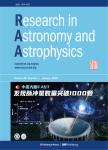版权所有:内蒙古大学图书馆 技术提供:维普资讯• 智图
内蒙古自治区呼和浩特市赛罕区大学西街235号 邮编: 010021

作者机构:?anakkale Onsekiz Mart University Faculty of Sciences and Arts Physics Department ?anakkale Onsekiz Mart University Astrophysics Research Center and Ulupnar Observatory Istanbul University Institute of Graduate Studies in Science Programme of Astronomy and Space Sciences ?anakkale Onsekiz Mart University School of Graduate Studies Department of Physics ?anakkale Onsekiz Mart University School of Graduate Studies Department of Space Sciences and Technologies ?anakkale Onsekiz Mart University Faculty of Engineering Computer Engineering
出 版 物:《Research in Astronomy and Astrophysics》 (天文和天体物理学研究)
年 卷 期:2022年第8期
页 面:36-50页
核心收录:
学科分类:07[理学] 070401[理学-天体物理] 0704[理学-天文学]
基 金:supported in part by the Scientific and Technological Research Council (TUBITAK) under Grant No. 120F330 Funding for the TESS mission is provided by the NASA Explorer Program
摘 要:The existence of pulsating stars in eclipsing binaries has been known for decades. These types of objects are extremely valuable systems for astronomical studies as they exhibit both eclipse and pulsation variations. The eclipsing binaries are the only way to directly measure the mass and radius of stars with a good accuracy(≤1%),while the pulsations are a unique way to probe the stellar interior via oscillation frequencies. There are different types of pulsating stars existing in eclipsing binaries. One of them is the δ Scuti variables. Currently, the known number of δ Scuti stars in eclipsing binaries is around 90 according to the latest catalog of these variables. An increasing number of these kinds of variables is important to understand the stellar structure, evolution and the effect of binarity on the pulsations. Therefore, in this study, we focus on discovering new eclipsing binaries with δ Scuti component(s). We searched within the northern Transiting Exoplanet Survey Satellite(TESS) field with a visual inspection by following some criteria such as light curve shape, the existence of pulsation like variations in the out-of-eclipse light curve and the Teffvalues of the targets. As a result of these criteria, we discovered some targets. The orbital variations were first removed from the TESS light curves and frequency analysis was performed on the residuals. The luminosity, and absolute and bolometric magnitudes of the targets were calculated as well. To find how much of these parameters represent the primary(more luminous) binary component, we also computed the flux density ratio of the systems by utilizing the area of the eclipses. In addition, the positions of the systems in the H-R diagram were examined considering the flux density ratios. As a consequence of the investigation, we defined 38 candidate δ Scuti stars and also one Maia variable in eclipsing binary systems.